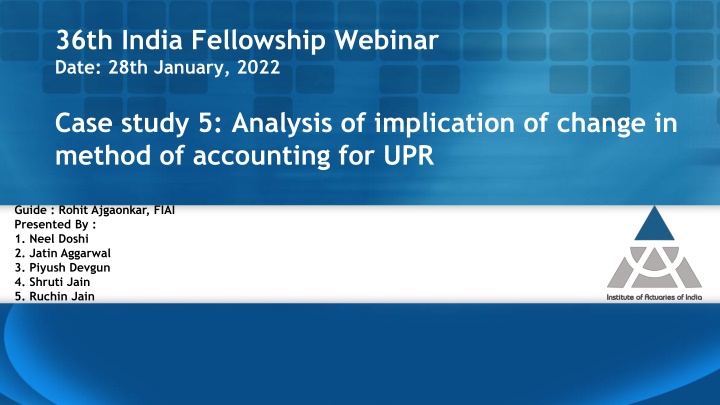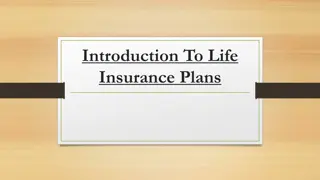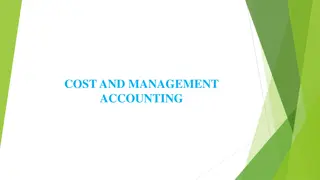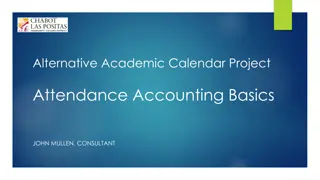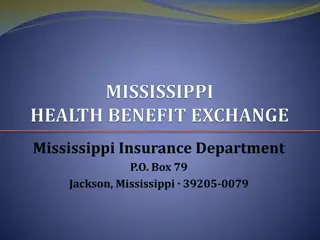Analysis of Implication of Changing UPR Accounting Method in General Insurance
This presentation discusses the impact of changing the method of accounting for Unearned Premium Reserve (UPR) in a general insurance company in India. The analysis explores the implications on earnings, premium and claim liabilities, profit/loss, and solvency due to transitioning from the 1/365th method to the percentage of net written premium method as per regulations. Key points include background on UPR, agenda covering impact on different business segments, and insights on the regulatory framework.
Download Presentation

Please find below an Image/Link to download the presentation.
The content on the website is provided AS IS for your information and personal use only. It may not be sold, licensed, or shared on other websites without obtaining consent from the author.If you encounter any issues during the download, it is possible that the publisher has removed the file from their server.
You are allowed to download the files provided on this website for personal or commercial use, subject to the condition that they are used lawfully. All files are the property of their respective owners.
The content on the website is provided AS IS for your information and personal use only. It may not be sold, licensed, or shared on other websites without obtaining consent from the author.
E N D
Presentation Transcript
36th India Fellowship Webinar Date: 28th January, 2022 Case study 5: Analysis of implication of change in method of accounting for UPR Guide : Rohit Ajgaonkar, FIAI Presented By : 1. Neel Doshi 2. Jatin Aggarwal 3. Piyush Devgun 4. Shruti Jain 5. Ruchin Jain
Introduction to Guide Our Guide for this presentation is Mr. Rohit Ajgaonkar, FIAI Rohit is currently the Appointed Actuary of Raheja QBE General Insurance Rohit has about 11 plus years of experience spread across life insurance, General insurance and consulting. Prior to Raheja QBE General Insurance, Rohit has worked as Chief Actuary of Edelweiss General Insurance and also in consulting firms like Ernst & Young. www.actuariesindia.org
Case study An analysis on the implication of changing from the current 1/365th method of accounting for UPR to the percentage of net written premium method as prescribed in the regulation You are the appointed actuary of growing general insurance company in India which writes property, motor and health insurance business. Your CEO has asked you to look into the Insurance Regulatory and Development Authority of India (Preparation of Financial Statements and Auditor s Report of Insurance Companies) (First Amendment) Regulations, 2021 and conduct an analysis on the implication of changing from the current 1/365th method of accounting for UPR to the percentage of net written premium method as prescribed in the regulation. Discuss the impact of change in UPR estimation on: Earnings Premium and claim liabilities Profit/loss Solvency www.actuariesindia.org
Agenda UPR background and change in method of accounting Impact on motor business Impact on property business Impact on health business Impact on solvency Conclusion www.actuariesindia.org
Agenda UPR background and change in method of accounting Impact on motor business Impact on property business Impact on health business Impact on solvency Conclusion www.actuariesindia.org
Background As per Section 2(p), Chapter 1 of The Insurance Regulatory and Development Authority (General Insurance Claims), Unearned premium reserve means the amount set aside from premiums written before the accounting date to cover risks incurred after that date. Unearned premium shall be shown separately under the head Current Liabilities and appropriate disclosures regarding management s basis of assessment shall be made in the financial statements. As per the IRDAI (Preparation of Financial Statements and Auditor s Report of Insurance Companies) (First Amendment) Regulations, 2021, the UPR for segments other than marine hull shall be computed as: 50% of net written premium during the preceding 12 months; or On the basis of the 1/365th method on the unexpired period of the respective policies www.actuariesindia.org
1/365 method Under the 1/365th apportionment method, the unearned premium reserve is the aggregate of the unearned premiums, calculated on a pro-rata basis, in respect of the premiums relating to the unexpired periods of the respective insurance policies at the end of the financial period. Unearned premium is calculated as follows: ??? ???? ?????? ????????? ???? Written Premium 365 The below table shows a computation of unearned premium as per the 1/365 method (as on 31st March 2021): Unearned premium 121.92 755.30 Policy Premium Start date End date Earned premium 1 2 500 898 28-Jun-20 1-Feb-21 27-Jun-21 31-Jan-22 378.08 142.70 www.actuariesindia.org
50% method This method is also known as the flat rate method. The unearned premium reserves are determined by applying a 50% weightage on the premiums written. Unearned premium is calculated as follows: 50% Written Premium The below table shows a computation of unearned premium as per the 50% method (as on 31st March 2021): Unearned premium 250 449 Policy Premium Start date End date Earned premium 1 2 500 898 28-Jun-20 1-Feb-21 27-Jun-21 31-Jan-22 250 449 www.actuariesindia.org
Summary As can be seen from the previous two slides, the portion of earned and unearned premiums can vary significantly under both the methods. Comparison of UPR methods 1000 800 600 Hence the change in methodology would be expected to have an impact on earnings, profit/loss, solvency. 400 200 0 As a part of the next sections, we will looks at the how the change impacts various business lines differently. Earned premium Unearned premium 1/365 50% www.actuariesindia.org
Agenda UPR background and change in method of accounting Impact on motor business Impact on property business Impact on health business Impact on solvency Conclusion www.actuariesindia.org
Motor Business - Seasonality Premium distribution Overall industry wise trend suggests more business being written in 3rd and 4th Quarter of the year. Relatively higher business in Q3 is probably due to the festive season and discounts given on vehicles. FY 20-21 is more skewed towards Q3 and Q4, could be an impact of covid. Similar trend is observed on both OD and TP business. Based on industry wise segment level data Source: https://www.irdai.gov.in/ www.actuariesindia.org
Impact on Motor Business UPR/Earnings As more business is written in second half of year, UPR based on 365 basis would be higher than 50% as shown below. UPR would be underestimated due to change in the methodology to 50% basis and overestimate the earned premium. FY 20-21 is more skewed, covid impact. Increased earnings in 1st year with less earnings left for future years. Assumption: uniform business within quarter taken as approximation for 1/365th method. www.actuariesindia.org
Impact on Motor Business Premium Assuming growing business, a projected estimate suggests in 1st Yr - significant increase in Net EP, due to mismatch in opening UPR on 365 basis(high) and closing UPR on 50% basis(low). In next year, Earned premium stabilizes as both opening and closing UPR would be on consistent basis. In scenario of significant dip in NWP, decrease in NEP on 50% basis would be more significant. Assumption: FY 21-22 1st year of change in methodology Business is growing and premium distribution based on past data www.actuariesindia.org
Impact on Motor Business Claims Higher EP improves the Loss ratios initially, though any claims arising in future when no, or less earnings left might distort the performance. Claims ratio might look better in the 1st year due to significant increase in NEP and revert to consistent lines in subsequent years. Profit/Loss to 5% of EP. 1st year shows significant increase in profits due to increase in Earned premium. Impact of change in methodology on profits reduces in 2nd year as NEP stabilizes. Profits increased from 5% of EP to 9% of EP in 1st year and next year again reduces Assumptions: EOM as 30% of WP LR is assumed to be constant at 65%. No change assumed in IBNR. Business is growing. Industry level data taken for illust n. www.actuariesindia.org
Motor : Conclusion Motor business is slightly skewed towards second half of year. If business increasing, Changing the UPR methodology to 50% method would underestimate the UPR and overstate the earnings. If there is dip in business, earnings by 50% method will be lower. Higher earnings lead to lower loss ratios, though claims in future with less earnings might distort the portfolio performance. Increase in Earned premium due to change in methodology will have incremental temporary impact on profits in first year. Earned premium and Profits will revert to consistent lines in the subsequent years. Notes Multi year TP policies considered to be earned on yearly basis. No change is assumed in reserving methodology. PDR may need to be relooked at based on overall performance of the company. www.actuariesindia.org
Agenda UPR background and change in method of accounting Impact on motor business Impact on property business Impact on health business Impact on solvency Conclusion www.actuariesindia.org
Property: Types of Coverages Fire Engineering Others Hull (AIT, Cargo, etc) www.actuariesindia.org
Seasonality of the Property Business Seasonality of Premium Written - Marine Hull Fire Business is skewed towards the first half of the financial year Marine Hull business is skewed towards the second half of the financial year Engineering book is written fairly uniformly over the year 50% 45% % of Premium Written 40% 35% 30% 25% 20% 34% 32% 15% 29% 27% 26% 22% 10% 16% 13% 5% 0% Year 2018-2019 2020-2021 Q1 Q2 Q3 Q4 Seasonality of Premium Written - Engineering Seasonality of Premium Written -Fire 50% 50% 45% 45% % of Premium Written 40% % of Premium Written 40% 35% 35% 36% 30% 30% 31% 25% 25% 26% 24% 20% 20% 23% 21% 20% 15% 19% 15% 29% 27% 25% 24% 24% 24% 23% 23% 10% 10% 5% 5% 0% 0% Year 2018-2019 2020-2021 Year 2018-2019 2020-2021 Q1 Q2 Q3 Q4 Q1 Q2 Q3 Q4 www.actuariesindia.org
Setting Context ABC Insurance company Premium Written INR 45m INR 50m INR 55m INR 65m INR 0m Year 0 Year 1 Year 2 Year 3 Year 4 Year 5 Insurer starts writing property book uses 1/365th method for UPR estimation In Year 3, insurer switches to 50% methodology for accounting for UPR Continues using 50% approach stops writing property contracts Portfolio Mix Our company ABC insurer: Started writing property book in Year 0 10% 15% Premium volumes have steadily grown over the years Marine Hull It used 1/365th method to estimate UPR till the end of Year 2 Fire Switched to 50% method to estimate UPR in Year 3 Engineering Continued using 50% method from Year 2 closing onwards 75% www.actuariesindia.org
Comparison 1/365th vs 50% Methodology Year 1 Closing 1/365th Basis Year 2 Closing 1/365th Basis Year 3 Closing 1/365th Basis Year 4 Closing 1/365th Basis INR 26.5m INR 65.0m INR 31.3m INR 60.2m -INR 36.1m -INR 13.0m INR 11.1m Year 5 Closing 1/365th Basis INR 31.3m INR 31.3m -INR 18.8m INR 0.0m INR 12.5m Total 1/365th Basis INR 215.0m -INR 129.0m -INR 43.0m INR 43.0m 1 Opening UPR 2 Written Premium 3 Closing UPR 4 Earned Premium (1+2-3) 5 Incurred Claims 6 Expenses 7 Underwriting result ( 4 -5 -6) INR 0.0m INR 45.0m INR 21.7m INR 23.3m -INR 14.0m -INR 9.0m INR 0.3m INR 21.7m INR 50.0m INR 24.1m INR 47.6m -INR 28.6m -INR 10.0m INR 9.0m INR 24.1m INR 55.0m INR 26.5m INR 52.6m -INR 31.6m -INR 11.0m INR 10.0m - - - - - Year 1 Closing 1/365th Basis Year 2 Closing 50% Basis Year 3 Closing 50% Basis Year 4 Closing 50% Basis INR 30.3m INR 65.0m INR 35.8m INR 59.5m -INR 36.1m -INR 13.0m INR 10.4m Year 5 Closing 50% Basis INR 35.8m INR 35.8m -INR 18.8m INR 0.0m INR 17.0m Total 50% Basis INR 215.0m -INR 129.0m -INR 43.0m INR 43.0m 1 Opening UPR 2 Written Premium 3 Closing UPR 4 Earned Premium (1+2-3) 5 Incurred Claims & Expenses 6 7 Underwriting result ( 4 -5 -6) INR 0.0m INR 45.0m INR 22.5m INR 22.5m -INR 14.0m -INR 9.0m -INR 0.5m INR 22.5m INR 50.0m INR 27.5m INR 45.0m -INR 28.6m -INR 10.0m INR 6.4m INR 27.5m INR 55.0m INR 30.3m INR 52.3m -INR 31.6m -INR 11.0m INR 9.7m - - - - - Expenses Assumptions: Expenses are 20% of written premium Loss ratio is assumed to be constant at 60% No change assumed in IBNR www.actuariesindia.org
Profitability Pattern Profitability Pattern -50%* Method Profitability Pattern -1/365th Method 50,000,000 50,000,000 45,000,000 45,000,000 40,000,000 40,000,000 12.5M 35,000,000 17.0M 35,000,000 30,000,000 30,000,000 25,000,000 25,000,000 11.1M 43.0M 10.4M 20,000,000 43.0M 20,000,000 15,000,000 15,000,000 9.7M 10.0M 10,000,000 10,000,000 5,000,000 6.4M 5,000,000 9.0M - -0.5M (5,000,000) 0.3M Year 1 - Year 1 Year 2 Year 3 Year 4 Year 5 Total Year 2 Year 3 Year 4 Year 5 Total * Marine Hull, 100% of the written premium is considered for UPR www.actuariesindia.org
Property: Impact on Profit/Loss Year 2 Closing Year 3 Closing Switch from 1/365th to 50% Basis Year 4 Closing 1/365th Basis 50% Basis INR 21.7m INR 50.0m INR 24.1m INR 47.6m -INR 28.6m -INR 10.0m INR 9.0m INR 24.1m INR 55.0m INR 30.3m INR 48.8m -INR 31.6m -INR 11.0m INR 6.3m 30,250,000.00 INR 65.0m INR 35.8m INR 59.5m -INR 36.1m -INR 13.0m INR 10.4m 1 Opening UPR 2 Written Premium 3 Closing UPR 4 Earned Premium (1+2-3) 5 Incurred Claims 6 Expenses 7 Underwriting result ( 4 -5 -6) Proft - % of Earned Premium 20.00% 18.00% 19% 17% 16.00% 14.00% 12.00% 13% 10.00% 8.00% 6.00% 4.00% 2.00% 0.00% Year 2 Year 3 Year 4 www.actuariesindia.org
Conclusion Property insurance is an umbrella term and can encompass a variety of lines of business. As we saw earlier, Fire, Marine Hull and Engineering lines of business all are different in terms of the seasonality of business written Fire Skewed towards the first half Marine Hull Skewed towards the second half Engineering Written uniformly However, Fire business will often form the bulk of the premium volume, and therefore the closing UPR under 1/365th basis will be lower compared to 50% basis. The extent to which this happens will be driven to large extent by the portfolio mix of an Insurer. The change in methodology although will not impact the overall profitability, but would impact the recognition of the profits www.actuariesindia.org
Agenda UPR background and change in method of accounting Impact on motor business Impact on property business Impact on health business Impact on solvency Conclusion www.actuariesindia.org
Health: Types of Coverages Health Group and Retail Personal Accident Travel Corporate and Retail Credit Linked Health Plans www.actuariesindia.org
Health: Premium written by quarter Distribution of Premium 40% 38% 36% 35% 33% 32% 29% 30% 25% 25% 24% 24% 23% 25% 21% 21% 20% 20% 18% 17% 15% 15% 10% 5% 0% 2020-21 2019-20 2018-19 2017-18 Q1 Q2 Q3 Q4 Majority of health insurance premium is written in Q3 and Q4 with an exception of FY2020-21. Based on Standalone Health Insurers data: Source: https://www.irdai.gov.in/ADMINCMS/cms/frmGeneral_List.aspx?DF=MBFN&mid=3.2.8 The percentages may not add to 100% due to rounding off. www.actuariesindia.org
Health: Difference in Earning Computation 1,000 10,000 Difference in UPR 0 8,000 Difference in UPR (1,000) 6,000 Difference is calculated as new 50% method less old 1/365th method of the calculation of unearned premium. Written Premium (2,000) 4,000 (3,000) 2,000 Linear (Written Premium) (4,000) 0 3,000 10,000 Difference in Earned Premium 2,000 8,000 Initial 3 quarters huge difference in UPR As premium dips in Dec - 19, the UPR for 50% method becomes higher than 1/365th method. Difference in Earned Premium 1,000 6,000 0 Written Premium 4,000 (1,000) 2,000 Linear (Written Premium) (2,000) (3,000) 0 Based on Top 6 companies from private players in GI, Standalone health and PSUs: Source: https://www.irdai.gov.in/ADMINCMS/cms/frmGeneral_List.aspx?DF=SWDN&mid=3.2.13 www.actuariesindia.org
Health: Comparison of 2 scenarios Scenario 1: Increase in premium every quarter by 10% after March 2021 Scenario 2: Decrease in premium every quarter by 10% after March 2021 Comparison of Incurred Loss Ratio Comparison of Incurred Loss Ratio 40,000 80% 40,000 80% 78% 78% 30,000 30,000 76% 76% 74% 20,000 20,000 74% 72% 72% 70% 10,000 10,000 70% 68% 0 66% - 68% Mar-19 Mar-20 Mar-21 Mar-22 Mar-19 Mar-20 Mar-21 Mar-22 1/365th EP 50% EP ILR using 1/365th ILR using 50% 1/365th EP 50% EP ILR using 1/365th ILR using 50% The loss ratio as per the reserving exercise is assumed to be constant at 75%. Loss ratio as per 50% method is lower in the first year and it goes higher in the second year before coming close to the actual loss ratio in the third year. If the business increases, 50% method would lead to higher earnings in premium to support the claims, hence lower loss ratios and vice versa. www.actuariesindia.org
Health: Impact on Profit/Loss No change in premium earnings Impact of change in earnings in the first year of change Particulars (1) Opening UPR (1/365th) (2) add: Written premium (3) less: Closing UPR (1/365th) (4) Earned Premium = (1) + (2) - (3) (5) less: Incurred Claims (6) less: EOM (Commission + Expenses) Impact of change in earnings in the next year Particulars (1) Opening UPR (1/365th) (2) add: Written premium (3) less: Closing UPR (50% method) (4) Earned Premium = (1) + (2) - (3) (5) less: Incurred Claims (6) less: EOM (Commission + Expenses) Underwriting Results = (4) - (5) - (6) Amounts (1,595) Amounts 16,680 43,536 23,061 37,154 27,866 10,884 Particulars (1) Opening UPR (50% method) (2) add: Written premium (3) less: Closing UPR (50% method) (4) Earned Premium = (1) + (2) - (3) (5) less: Incurred Claims (6) less: EOM (Commission + Expenses) Underwriting Results = (4) - (5) - (6) Underwriting Results = (4) - (5) - (6) Amounts 21,768 63,741 31,871 53,639 39,779 15,935 (2,075) 16,680 43,536 21,768 38,448 27,866 10,884 (302) Assuming Expenses of Management (EOM) of 25% of written premium. Assuming the business is growing by 10% every quarter, the loss coming in from the underwriting decreases from 4% of earned premium to about 1% because of the increase in UPR. The next year, the loss again increases to 4% of earned premium. www.actuariesindia.org
Health: Conclusion Group Health and Corporate Travel coverages are written at the start of the year but will be recognized as only 50% earned. Retail Travel has short term policies most of which would have expired in the year but will now count towards UPR. About 60% of retail health business is written in last two quarters, hence, using 50% method will lead to higher earnings as compared to 1/365th method. Multi-year health insurance policies and credit linked health plans will also get 50% earned in the underwriting year leading to lower UPR. If the business is increasing, the earnings by 50% method will be higher leading to lower loss ratios and vice versa. The premium deficiency reserve may be required to allow for lower UPR being kept under the 50% method if there is a large difference between the UPR calculated by the two methods. Even when the premium earnings change, the reserving assumes to be on the same basis. The increase in profit or reduction in loss in the first year will only be a temporary change. www.actuariesindia.org
Agenda UPR background and change in method of accounting Impact on motor business Impact on property business Impact on health business Impact on solvency Conclusion www.actuariesindia.org
Solvency Computation Components of Solvency in Indian regime Available Solvency Margin (ASM) : Excess of assets over liabilities, subject to key specific adjustments like disallowance of inadmissible assets Required Solvency Margin (RSM) : Estimated at line of business level using the prescribed formula, taking into account Gross and net written premiums, and gross and net incurred claims Taking higher of premiums-based and claims-based RSM calculations Aggregating individual RSMs for all lines into the INSURER s total RSM Solvency Margin : Ratio of ASM to RSM with a minimum required level of solvency ratio set at 150% breaching which can lead to regulatory actions www.actuariesindia.org
Impact on Solvency- ASM Unearned Premium Reserves (UPR) : depending on the business and pattern, it is expected to increase/decrease. For Health, we expect a significant change (decrease) in UPR with movement from 1/365th method to 50%. For motor, the UPR should decrease slightly, whereas for property business, we expect minor increase in UPR. ASM Impact expected: As majority of Indian companies write significant proportion of Motor and Health business, the overall ASM is expected to increase. Assumption: We have assumed there would be no change in tax and deferred taxes, along with other technical reserves like PDR due to changes in UPR accounting. LOB Motor Health Property Overall Impact on ASM Slight increase Significant increase Slight decrease Increase www.actuariesindia.org
Impact on Solvency- RSM No impact expected on RSM : Written Premium : No change due to change in earnings Incurred claims : No change expected No change in IBNR claims reserve assumed and hence, incurred claims will not change www.actuariesindia.org
Impact on Solvency- Illustration Amounts in INR Crores Items NWP UPR UPR/NWP With UPR @1/365 With UPR @ 50% 614 340 55% 614 307 50% RSM ASM Solvency 129 247 191% 129 280 217% The above values are shown for illustration only. It shows the impact on solvency when a company transitions from 1/365th UPR approach (assumed UPR/NWP ~55%) to 50% UPR approach. The solvency ratio shows increase from 191% to 217%. www.actuariesindia.org
Agenda UPR background and change in method of accounting Impact on motor business Impact on property business Impact on health business Impact on solvency Conclusion www.actuariesindia.org
Conclusion Health Health Solvency Motor Motor Property Property As more business is written in the first half of the year, UPR estimated using a 1/365th basis will be lower than 50% of the written premium Switching from 1/365th basis to 50% Due to past trends indicating approx. 60% of health business is written in last 2 quarters, UPR is expected to reduce and earnings are expected to increase Portfolio mix between corporate (or group) and retail Due to past trends indicating approx. 60% of health business is written in last 2 quarters, UPR is expected to reduce and earnings are expected to increase Group Health, Corporate Travel and Personal Accident coverages may have minimal impact will be a major determinant. As more business is written in the second half of the year, UPR estimated using a 1/365th basis will be higher than 50% of the written premium Hence, UPR is expected to reduce No impact on RSM As more business is written in the second half of the year, UPR estimated using a 1/365th basis will be higher than 50% of the written premium Hence, UPR is expected to reduce and earnings are expected to increase and earnings are expected to increase As more business is written in the first half of the year, UPR estimated using a 1/365th basis will be lower than 50% of the written premium basis is expected to result in reduction of profit recognized in that year Overall ASM expected to increase for most of the companies which predominantly write Motor & Health business. www.actuariesindia.org
Thank you Case study 5: Analysis of implication of change in method of accounting for UPR Questions?
